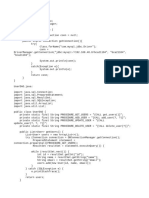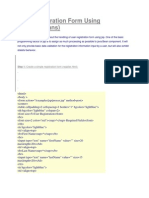Practice Project 1-Algorithm
Uploaded by
SouravPractice Project 1-Algorithm
Uploaded by
SouravAlgorithm: Searching for a Specific User and Updating the User
Information
Step 1: Set up the project structure
Create a new Java web project in your preferred IDE (e.g., Eclipse, IntelliJ).
Configure the project with the necessary dependencies, such as a web framework like
Spring MVC and a database connector.
Step 2: Create the entity class
Create a Java class to represent the user entity (e.g., UserEntity).
Define attributes like user ID, name, and salary.
Generate getter and setter methods for the attributes.
Step 3: Create the DAO (Data Access Object) class
Create a DAO interface (e.g., UserDao) that declares methods for CRUD operations
related to the user entity.
Use appropriate database libraries (e.g., JDBC, Hibernate) to interact with the database.
Step 4: Create the controller class
Create a controller class (e.g., MainController) that handles the user-related requests and
controls the flow of data between the JSP pages, service layer, and DAO layer.
Annotate the controller class with appropriate annotations (e.g., @Controller,
@RequestMapping) to map the request URLs.
Step 5: Create the JSP pages
Create a JSP page (e.g., index.jsp) to take in the user ID from the user.
Create a JSP page (e.g., success.jsp) to display an success message if the user details are
updated.
Create a JSP page (e.g.,user.jsp) to display the user details in an edit form.
Create a JSP page (e.g.,ditails.jsp) to display the user details.
Step 6: Implement the user details update
In the UserController class, define a method to handle the form submission from the
details.jsp
Use the @RequestMapping annotation to map the URL to this method.
Retrieve the updated user details from the request parameters.
Pass the updated user details to the MainController to update the user information in the
database.
Forward the request to the succes.jsp page.
Step 7: Test the application
Deploy the application on a web server (e.g., Apache Tomcat).
Access the application in a web browser and test the functionality by entering a user ID,
updating the user details, and verifying the confirmation message.
You might also like
- Advanced Programming and Technologies Assignment 1No ratings yetAdvanced Programming and Technologies Assignment 114 pages
- add update delete html and php in sql xampp serverNo ratings yetadd update delete html and php in sql xampp server6 pages
- College of Business Science & Technology: Project OnNo ratings yetCollege of Business Science & Technology: Project On33 pages
- CSE3146-Advanced JAVA Programming-Module 4 - JSP LabsheetNo ratings yetCSE3146-Advanced JAVA Programming-Module 4 - JSP Labsheet8 pages
- Database Application in JSP Using Netbeans: IndexNo ratings yetDatabase Application in JSP Using Netbeans: Index16 pages
- A Step By Step Tutorial Using JSP For Web Development With Derby DatabaseFrom EverandA Step By Step Tutorial Using JSP For Web Development With Derby DatabaseNo ratings yet
- Getting Started with Oracle WebLogic Server 12c: Developer’s GuideFrom EverandGetting Started with Oracle WebLogic Server 12c: Developer’s GuideNo ratings yet
- How To Perform Ajax Form Validation in Oracle Jdeveloper: 1. Introduction - What Is Ajax?No ratings yetHow To Perform Ajax Form Validation in Oracle Jdeveloper: 1. Introduction - What Is Ajax?14 pages



























































